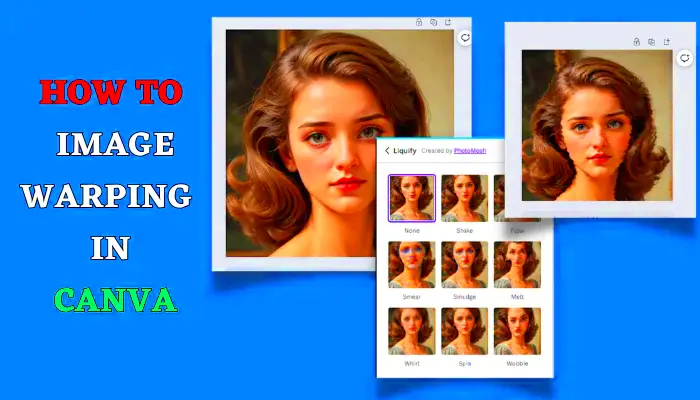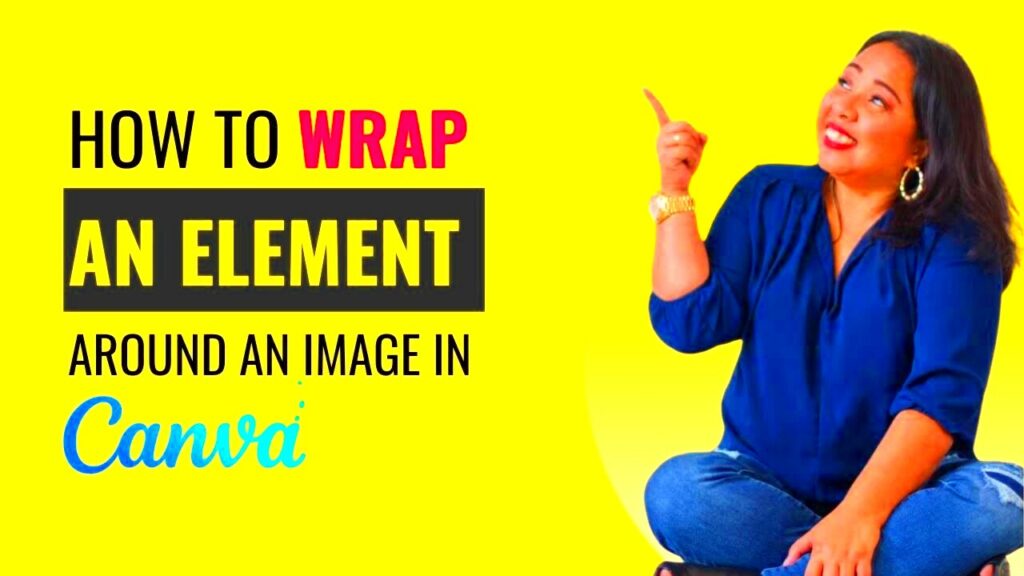In the realm of design adaptability plays a role. I recall the moment I discovered the image warping feature on Canva. I was working on a birthday poster for a friend and wanted the photo to seamlessly blend into an abstract shape. It was then that I understood the potential of this tool. With image warping you can tweak your images to align with your artistic concept.
In essence image warping allows you to flexibly distort and reshape your visuals. Rather than conforming to boundaries you have the freedom to adjust an images proportions to align with your creative vision. Whether it's for crafting social media content, presentations or event invitations this tool adds a distinct flair to your visuals.
Picture yourself wanting to add a touch of playfulness to a cloud or reshape an image into something quirky. This feature lets you do just that. Canva's user friendly design allows you to experiment with different tweaks transforming regular photos into stunning works of art.
Why You Might Want to Warp Images

There are numerous advantages to incorporating image warping into your creative projects. Here are some that have struck a chord with me
- Enhancing Creativity: Warping lets your imagination run wild. You can transform a simple photo into something truly unique.
- Tailoring to Fit: Sometimes, an image just doesn’t fit where you want it to. Warping can help it blend seamlessly into your design.
- Storytelling: An image can convey emotions or themes better when warped. For example, a bent tree can symbolize growth in an organic way.
- Creating Visual Interest: Warped images grab attention. They make viewers stop and take a closer look, which is what every designer hopes for.
In my journey I have discovered that the most designs are born from genuine emotions and adding a twist can infuse a unique flair. Embrace the opportunity to play around with this aspect as it may unveil delightful and surprising outcomes.
Also Read This: Develop Annual Reports with Canva Annual Report Template
How to Access the Image Warping Tool in Canva

Using the image warping feature in Canva is a breeze. If youre familiar with Canva, youll find it to be a simple process. Here’s a breakdown of the steps I typically follow when I want to distort an image.
- Open Canva: Start by logging into your Canva account or creating one if you haven’t already. The design possibilities are endless!
- Create a New Design: Click on “Create a Design” and choose your preferred format, whether it’s a social media post, flyer, or something else.
- Upload Your Image: Click on the “Uploads” tab on the left-hand menu and select the image you want to warp. Alternatively, you can use one from Canva’s library.
- Select the Image: Once your image is on the canvas, click on it to reveal the editing options.
- Find the Effects Option: Look for the “Effects” button on the top menu bar. This is where the magic begins!
- Choose Image Warping: Under the effects, you’ll see “Warp” options. Click on it to start adjusting your image.
Once you get your hands on the warping tool that’s where the excitement starts! You can move the corners, edges or even specific points of the image to shape it just the way you want. It’s similar to working with clay and giving it a unique touch.
Also Read This: Instagram Strategies for Small Business
Steps to Warp Your Images Effectively
Distorting images is a thrilling adventure that can yield stunning results with every twist and turn. I recall the joy of channeling my inner artist when I experimented with image warping on Canva for the time. Here’s a guide on how to navigate this artistic journey to achieve the most impressive results.
- Start with a Clear Vision: Before diving in, take a moment to visualize how you want your image to look. Sketch it out if you can; it helps to have a reference point.
- Select the Right Image: Choose an image that resonates with your idea. It can be a simple photo or something more complex. The key is to pick one that can adapt to your vision.
- Use the Warp Tool Wisely: After uploading your image, access the warp tool. Begin by gently pulling and pushing the image. It’s like stretching dough—too much force can lead to a mess.
- Experiment with Points: Use anchor points to manipulate specific parts of the image. This is where you can add those intricate details that make your design stand out.
- Review and Adjust: Don’t hesitate to step back and look at your work. Sometimes, a fresh perspective can help you catch things you might have missed.
- Seek Feedback: Share your design with friends or family. Their insights can offer new angles you might not have considered.
Keep in mind that warping goes beyond being a mere skill; it’s a creative expression. As you hone your craft you’ll discover your unique flow and flair along the way.
Also Read This: Hidden Horrors Unveiled: Exploring IMDb’s Dark Corners for Thrilling Finds
Best Practices for Image Warping
While working on warping images I came across several strategies that assisted me in honing my skills. Here are some of the key approaches I’ve discovered throughout my journey.
- Keep It Natural: Aim for a realistic warp. Avoid overdoing it; sometimes, less is more. Subtle adjustments can lead to elegant results.
- Use High-Quality Images: Starting with a high-resolution image ensures that your final product looks crisp. Low-quality images can distort and lead to unsatisfactory outcomes.
- Layering is Key: Don’t hesitate to layer multiple images or shapes. This adds depth and complexity to your designs, making them more engaging.
- Experiment Freely: Take risks with your designs! Try different shapes and styles. The beauty of Canva is that you can always go back to the original image if needed.
- Learn from Others: Browse through design communities or social media for inspiration. Seeing how others use warping can spark new ideas.
Based on what I have seen these methods turn image distortion from just a basic approach into an impactful artistic instrument. Each project presents a chance to convey ones creativity.
Also Read This: How to Link a Company in a LinkedIn Post
Common Mistakes to Avoid While Warping Images
The image warping feature is great but it can also bring about some challenges. I have definitely stumbled upon a couple of those pitfalls too! Here are some missteps to avoid.
- Over-Warping: It's easy to get carried away. Overdoing the warping can create images that look unnatural or distorted beyond recognition. Always aim for a balance.
- Ignoring Image Quality: Using low-resolution images can backfire. Warping can accentuate pixelation, making your design look unprofessional.
- Neglecting Composition: Always keep the overall composition in mind. An isolated warped image might look great, but it needs to fit well within your overall design.
- Not Saving Variants: I’ve often forgotten to save different versions of my designs. It’s crucial to keep backups so you can revisit earlier ideas if needed.
- Skipping Final Review: Before you finalize your design, take a moment to review it critically. Sometimes the best insights come when you’re about to hit that “download” button.
Being mindful of these pitfalls can help you improve your warping abilities and produce visuals that truly connect with people. Remember, each design is an expression of your imagination and it deserves to stand out!
Also Read This: Exploring What The Hales YouTube Live Today and Their Latest Streams
Creative Uses of Warped Images
When I stumbled upon the image distortion tool in Canva it was like finding a hidden gem of artistic expression. The possibilities appeared endless and I was eager to dive in. Twisted pictures can bring an element to your creations and elevate everyday visuals into something truly remarkable. Here are a few imaginative ways to incorporate warped images.
- Unique Branding: Many brands aim for a distinctive visual identity. Warping logos or brand elements can help you stand out in a crowded marketplace. I once warped a friend's startup logo, and it sparked conversations wherever it appeared!
- Dynamic Social Media Posts: In the world of social media, grabbing attention is essential. Warped images can add that eye-catching element. Think of using distorted shapes to highlight quotes or important information.
- Invitations with Flair: Whether it’s a wedding or a birthday, warped images can bring a sense of fun and personality to invitations. I vividly remember designing my cousin's wedding invites with warped floral designs; they were a hit!
- Storytelling Elements: Use warped images to symbolize concepts or emotions in your storytelling. For instance, a warped road can depict a journey filled with twists and turns.
- Artistic Projects: If you're into digital art, warping images allows you to experiment with abstract concepts. You can morph shapes and colors into something that truly represents your artistic vision.
Based on what I've seen the secret to successful image manipulation is to enjoy the process. The more you experiment and get creative the more distinctive your creations will turn out to be. So go ahead and unleash your imagination without holding back!
Also Read This: Extracting Emails from LinkedIn Profiles What You Should Know
FAQs About Canva Image Warping
As I’ve explored image manipulation in Canva I’ve come across a lot of questions and interests from friends and fellow designers. Here are some common inquiries that could help clarify any uncertainties.
- Can I use any image for warping?
Yes, you can warp almost any image! However, high-resolution images work best to ensure clarity and prevent pixelation. - Is warping irreversible?
Not at all! Canva allows you to undo changes, so if you don't like the warped version, you can revert to the original image easily. - Are there limits to how much I can warp an image?
While there isn’t a strict limit, over-warping can make images look unrealistic. It’s always a good idea to keep it subtle. - Can I combine warping with other effects?
Absolutely! Combining warping with filters, overlays, and text effects can lead to stunning results. I often mix and match for unique designs. - How can I learn more about effective warping?
Experimentation is key! Besides that, watching tutorials or exploring design communities can provide fresh insights and ideas.
These frequently asked questions capture my personal exploration of image distortion. I trust they will assist you in your artistic pursuits!
Conclusion on Using Image Warping in Canva
As I conclude my journey into the realm of image warping in Canva I find myself pondering the impact this feature has had on my design mindset. It goes beyond simply distorting visuals; it challenges the boundaries of imagination. The ability to warp images lets us showcase our individuality and infuse richness into our creative works.
From what I’ve seen, I believe that the key to design is being open to trying out different ideas. Embrace the flaws and be bold in exploring new concepts. Whether you’re putting together an eye catching social media post or creating a touching invitation using image manipulation can add a unique flair to your work.
Get ready to unleash your creativity by gathering your go to pictures and exploring Canva. Let your imagination run wild because the possibilities are endless! I’m excited to see the stunning designs that you come up with.
